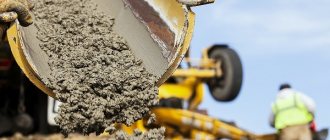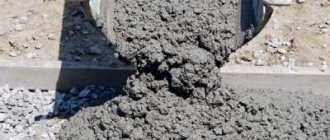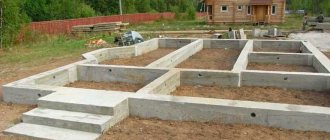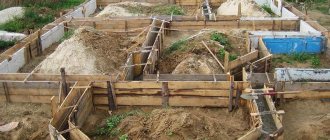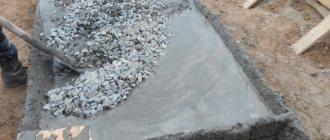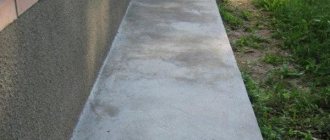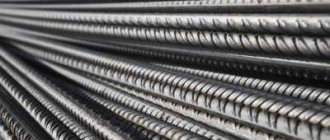The reliability of a building structure is determined by its foundation. Different types of concrete mixtures are used in construction, but only heavy varieties are chosen for building the foundation. The filler for them is massive fractions of rocks: crushed stone, gravel, etc. Therefore, the material is characterized by increased strength and long service life. The grades of concrete for the foundation can be different. Let's figure out what they are and how to choose the best option.
What grade of concrete is needed for the foundation of a house?
The reliability of the foundation of any structure is the key to its durability. Various types of concrete are used in construction, but if we are talking about the foundation of a house, then only heavy ones are used to load it into the formwork - this is an axiom. We will talk about how to choose the right brand for artificial stone.
Concrete mixtures for the foundation of a house.
Heavy concrete is called concrete in which the filler is fractions of rocks (mainly crushed stone of various types). The sizes of granules for the foundation of a private house are selected from 6 mm. Such solutions are designated by brand from M100 to M500.
What should you focus on?
There is no clear advice on choosing a solution. When deciding what kind of concrete is needed for the foundation of a house, you have to take into account a whole range of factors and, as a rule, look for a compromise option. In this case, the cost of production is not of paramount importance. Even the most expensive brand is characterized by certain restrictions in its use, so all further recommendations are only of a general plan.
1. Expected load.
When calculating it, the following components are taken into account:
- the material from which the house is built - brick, wood, aerated concrete or others. It is clear that the weight of the frame structure will be significantly lower than, for example, from reinforced concrete;
- number of floors of a private building;
- “filling” of the house - engineering equipment, household appliances, furniture, personal belongings. You also need to consider the prospect of purchasing something else.
When determining the grade of concrete for the foundation, it is necessary to ensure a certain margin of safety. Possible errors in calculations, errors and various force majeure circumstances cannot be ruled out.
- M100. As for a private house - if it is made of wood or aerated concrete on the 1st floor - this brand (with some restrictions) can be used. Although most often it is used only at the stage of preparation for laying the foundation. If grade 100 is chosen for a house (for example, aerated concrete), then a “cushion” of the same solution, at least 100 mm, must be installed.
- M150. For small light buildings. For example, if the house is being built from aerated concrete, cinder blocks and similar materials.
- M200. This brand is suitable for the foundation of a two-story house with a light ceiling. On such a foundation, prefabricated panel structures and buildings made of cellular concrete are often erected.
- M250. For the foundations of houses made of aerated concrete or wood, if they have no more than 3 floors.
- M300, 350. These grades are used for pouring foundations for heavy buildings. For example, when building a private house made of brick.
Pouring the strip foundation of the house.
- In some cases (on problematic soils and in other situations), concrete M400 and 450 is used. It is not advisable to use a grade higher than those indicated in the private sector. Such expenses can hardly be considered justified, given the high cost of the product.
- For a private brick building, the concrete grade M250 is selected for a strip foundation, provided that it is one-story.
There is an opinion that mortars of grades 200 and below are not used for arranging the foundation of a residential building of any type. However, opponents point out that factors such as soil properties, reinforcement density, and design features of the house should be taken into account. It is acceptable to use grades M100 – 200, but this is not a rule, but special cases. The choice of cheap brands should be made based on accurate calculations, since M350 is considered optimal for the construction of the foundation of a residential building (both in terms of the strength of the artificial stone and in price).
Under no circumstances are aerated concrete and its cellular analogues used for foundation construction!
Detailed table of proportions of concrete grade.
2. Soil characteristics.
- Sandstone, rock - such soils are homogeneous in composition, so the entire load on the base is distributed evenly. For lightweight houses, grades 150–250 are suitable, for more massive buildings: 300–400.
- Heaving soils (for example, clay, loam) - they are considered problematic in construction. The peculiarity is increased soil displacements during sudden temperature changes. In such conditions, it is not recommended to use a grade below 350 for the foundation.
The configuration of underground aquifers also matters. Taking into account the specifics of their location, you need to focus on such a characteristic as water resistance. It is relevant for houses with a basement floor.
Features of arranging the foundation of a house.
The base can be protected from contact with liquids by using better waterproofing, installing a reliable drainage system, and introducing hydrophobic additives. If you focus only on the brand, then you should know that the higher it is, the better the moisture resistance. This indicator is designated by the letter “W”. The grade of concrete for water resistance is expressed as a value from 2 (weak) to 8 (high).
When choosing a solution based on this characteristic, you need to calculate what is more profitable: purchase more expensive concrete (W7–8) or spend money on materials and carry out additional treatment of the foundation of the house.
A truly working legal way to save money. Everyone needs to know this!
3. Climate features.
Here frost resistance comes to the fore. It shows how many freeze/thaw cycles the concrete does not change its performance properties. In the marking it is indicated by the letter “F”. The result of an incorrect choice in this parameter is the appearance of cracks on the base and walls of the basement of a private house. In combination with other mistakes made (for example, during technological operations), this may appear after the first winter.
For our latitudes, it is advisable to purchase concrete with an index of at least F75 for the construction of the foundation, regardless of the brand.
Strength of compositions of different grades of concrete.
Self-cooking
During the preparation process, it is necessary to mix the components in the correct proportions, taking into account the brand of cement used:
| Cement brand | Cement | Sand | Gravel | Water |
| M100 | 1 | 4,1 | 6,1 | 1,1 |
| M200 | 1 | 2,5 | 4,2 | 0,9 |
| M300 | 1 | 1,7 | 3,2 | 0,65 |
| M400 | 1 | 1,1 | 2,4 | 0,5 |
| M500 | 1 | 0,8 | 1,5 | 0,4 |
Mixing in a concrete mixer
If you need to mix more than 50 liters of concrete at once, you need to use a concrete mixer.
First, use a measuring bucket to pour dry components into a concrete mixer , maintaining the correct order - cement, sand, crushed stone.
All this is mixed dry for several minutes. Next, water is poured in and everything is mixed together for 12-16 minutes. The finished concrete mixture is moved into special containers and supplied to the pouring site.
What else can you clarify?
1. Size of filler granules.
For a slab foundation, this is not so important, since it is rarely installed for private buildings. But for the tape type, and especially the columnar type, this is relevant. Why? For the first, concrete is poured into a horizontally oriented formwork, for the second - into a vertical form. But in any case, the base is strengthened, regardless of its type. After loading the solution, the mass must be compacted to remove excess water and air.
The quality of compaction and, as a consequence, the uniformity of the structure and the strength of the foundation depend on how tightly the reinforcement is made (cell parameters). If pipes are used for a columnar foundation, then you need to purchase concrete with fractions of no more than 4-6 mm.
2. Type of filler.
Concrete containing granite crushed stone is considered the most reliable. On this basis, the house will stand for a very long time.
3. Mobility of the solution.
Another characteristic (indicated by the letter “P”), which does not depend on the brand. We can say that it shows how convenient it will be to work. Numerical values are from 1 to 5 (the most liquid composition). If it is loaded manually, then an indicator within 2-3 is sufficient. When using a feed pump, you should focus on concrete not lower than P4.
It is prohibited to dilute the solution to increase its fluidity. Adding water simplifies the work, but at the same time changes the proportion of components, reduces the grade and, as a result, the reliability of the foundation.
There is often confusion with the concepts of brand and class. Without going into details, suffice it to say that the latter term is just a derivative of the first. Class (B) is a more accurate parameter, while brand is an average indicator. In any case, the higher their numerical values, the stronger and more durable the base will be.
Required Fillers
As noted above, to prepare the solution, it is necessary to use sand of a certain fraction. In some cases, coarse crushed stone and gravel are added to the solution. If plastering and masonry work is planned, only fine sand should be used.
Currently, manufacturers offer this material of river or ravine origin. It contains a large amount of clay particles, as well as other impurities. Therefore, it is not recommended to buy such sand for building a foundation.
As for peat, glass, soil and many other similar substances, they should never be used.
Factors influencing the selection of the composition brand.
There is no universal recipe, and cost is not always considered the main factor in determining the quality of concrete. Even in expensive mixtures there are recommendations for use and restrictions:
Type of concrete for strip foundation.
- The main selection parameter is the load on the foundation. When this indicator is high, then the grade of concrete must be higher.
- Different types of foundation are suitable for different types of soil. For loams and clay, you can buy M350 concrete, and for sandstone and rocky rocks - M150 and 250. At the same time, we must not forget to take into account the seismic resistance of the building.
- When the soil is heaving, it is worth making a pile-strip foundation.
- An important point is the water permeability of the foundation, which depends on the occurrence of groundwater. Seasonal fluctuations also need to be taken into account.
M200
This brand of concrete is quite suitable for the foundation of a one-story house. In this case, a prerequisite is the absence of a groundwater level located too close to the surface.
Various floor slabs and piles are made from this material. In addition, it is used to fill the foundation in frame-panel houses.
The ratio of components in the solution.
Before preparing concrete for the strip foundation of a house, you will have to study the required proportions of mixing crushed stone, sand and cement. The properties of the building mixture are affected by each of the listed ingredients that are included in its composition.
The thickness of the solution depends on the water used. If the mixture turns out to be liquid, there will be a lot of air in it, and the components will not be mixed evenly. When pouring the strip foundation of a house, the cement laitance will flow down. The structure will weaken and burst due to crushed stone settling downwards . The sand remaining at the top will not be able to withstand heavy loads.
What brand of concrete is needed for a strip foundation.
The main binding component is cement, which forms a plastic mixture. After hardening, it becomes a strong monolithic structure, and the load-bearing capacity of the foundation of buildings depends on the strength indicator.
Thick concrete is considered the ideal option, however, it is difficult to achieve the desired consistency on your own. In industrial settings, vibrators are used to distribute the ingredients throughout the mixture.
You can prepare concrete for a strip foundation when laying a house using a concrete mixer. You can achieve a thick consistency by tamping with a stick and a vibrator.
How ingredients affect the quality of concrete.
The exact formula and proportions are used in industrial production conditions, where the same level of humidity is always maintained . The main guideline for adding water is the ratio: a bucket of cement is slightly less than a bucket of water. The mixture should not be too liquid or thick.
If suddenly the concrete cracks after pouring, the cracks must be repaired immediately with fresh mortar.
Brand of concrete for the strip foundation of a house.
Durable crushed stone plays an important role in the formation of a strip foundation. It needs to be selected only in a single large fraction of 20-25 mm so that the mixture is homogeneous.
The quality indicator of the foundation depends on the condition of the sand, and therefore, when selecting it, they focus on the use of clay. During construction, quarry, river and artificial sand are used. When choosing this material, it is better to give preference to the large fraction without clayey impurities.
Various additives
To obtain a high-quality solution, additionally add:
- Thinning additives. They help make the mixture frost-resistant and also minimize the amount of water used.
- Plasticizer. This additive improves fluidity. It makes it possible to create a shape of any configuration from concrete. In addition, the plasticizer has a positive effect on the laying properties.
- Hardening accelerator. Thanks to it, the mixture hardens faster.
- Aerating. They are used to reduce the amount of water, as well as to increase frost resistance and thermal insulation properties.
- Waterproofing, sealing and water-repellent agents that reduce the permeability of concrete.
These additives can be purchased at any hardware store. At the same time, you need to understand that you should not overdo it with them. They should be about 2% of the total mass.
However, there are substances that you can not buy, but make yourself at home. Some professionals use soap solution as additives. When using such drugs, it is recommended to adhere to a certain dosage. If the proportion is incorrect, the solution will be of poor quality.
Scope of application of various grades of concrete.
The construction of a strip foundation for a house can be used for various construction technologies. On the created ribbons you can place log, frame, half-timbered, panel and panel private houses. In case of deep laying of the tape, brick bungalows, concrete buildings, townhouses and chalets are installed.
According to SNiP standards, it is necessary to use concrete grades for the strip foundation of a house in accordance with the building construction technology. You can determine what brand of concrete is needed for the foundation after studying their characteristics:
- M150 is a grade for concreting verandas, terraces and reinforced concrete pads for the main foundation.
- M200 is a grade for foundations in low-rise construction, terrace walls, external and internal stairs, blind areas.
- M300 is a brand for the foundation of attic and two-story cottages, monolithic partitions, ceilings, stairs and walls.
- M350 is a brand for the foundation of a house with difficult operating conditions.
- M400 is a grade needed for the foundations of houses located in earthquake-prone areas, swampy areas and coastal areas.
Ideal concrete mix.
In practice, it has been proven that sufficient strength of concrete grade M150 is noted for light walls of one-story structures made of aerated concrete, SIP panels and half-timbered houses. When determining what grade of concrete is needed for a strip foundation, it becomes clear that in most cottage buildings, M200 grade concrete is used.
No less important is the choice of the right brand of concrete for the foundation . The quality of the tape reinforcement is considered. In the longitudinal belt, it is better to use a 12 mm corrugated type of reinforcement, and for horizontal jumpers, the racks can be made of rods with a smaller cross-section or completely smooth reinforcement. When extending the rods, an overlap of 15 diameters should be made.
Concrete grades M400 – M250 should be poured in several steps using special technology:
- Vertical cut-off.
- Expansion joint at an angle of 450.
- Other methods.
The mixture cannot be poured into the formwork without heating if it is cold outside. In hot weather, the top layer must be protected from excessive evaporation.
The choice of mixture for construction is influenced by the frost resistance index, designated by the letter F. It reflects the number of freezing/defrosting cycles that the solution can withstand without losing its strength index. When constructing buildings for permanent residence, this indicator can be ignored, in particular when the base is insulated around the perimeter and a blind area is created .
Subtleties of selecting the grade of concrete for the foundation tape.
The grade of concrete is chosen depending on the type of foundation and operating conditions. In difficult situations, additional protection of the base from aggressive environments and heaving is needed. The key technologies for strengthening the foundation and increasing its resource are:
Brand of concrete for strip foundation.
- Insulation of walls from the outside - the tape is covered with polystyrene foam to the base from ground level. The bottom of the trench is lined with the same material.
- Waterproofing - in a private building by pasting with rolled material, spraying polyurethane foam, impregnation with special compounds.
- Drainage - corrugated pipes are laid around the perimeter of the foundation to collect excess moisture from the soil.
- Blind area - does not allow melt, rain and flood waters to penetrate into the base material.
- Gutter – designed to collect water from the roof and storm drains.
During the complex of the above measures, the external load on the foundation is reduced. Thus, it becomes possible to use a cheaper brand of concrete. In any situation, strength calculation is a must to ensure high safety and service life of the cottage.
Base without basement
Formwork for the foundation must be placed not only around the perimeter of the house, but also in those places where there will be partitions.
If the design of your house does not provide for a basement floor, then the formwork must be immediately placed under the base walls, not only around the perimeter, but also under the partitions. Next, work is carried out on linking the reinforcement. When the formwork is laid out and the reinforcement is tied, in a word, when everything is ready for pouring concrete, it’s time to deliver the building mixture itself. It is best to bring in the filling mixture using a mixer. In the mixer, the concrete will be constantly stirred, and when it arrives at the construction site, it will actually flow.
The depth of the columnar foundation should be more than 1 meter.
When the concrete used for pouring is liquid, it becomes possible to avoid compacting the construction mixture with vibratory rammers, although this will also not be superfluous. If you transport concrete on a dump truck, then by the time it is delivered to your construction site, it will be compressed, and all the water will simply flow out. As a result of such transportation, a thick, sticky mass will arrive at the construction site, which will be quite difficult to remove even with a shovel, let alone pour.
If possible, it is better to fill the entire base during the day, this will avoid layering of the building mixture. If such completion of the work is not possible, then the construction mixture must be poured with belts of approximately equal height along the entire perimeter.
A concrete foundation, if installed correctly, will become a practical and reliable support for your home.
Brand of concrete for strip foundation: choice depending on the weight of the building and soil characteristics.
As you know, the durability and strength of any structure depends on the quality of the foundation on which it is based. In private construction, as a rule, 3 types of structures are used: columnar or pile, slab and the most common strip, which we will talk about. The grade of concrete for the strip foundation of a private house is the most important indicator of its quality.
Brand of concrete for the strip foundation of the house.
Made
The technology for constructing a prefabricated foundation is similar to a strip foundation. During its construction, special blocks (FBS) are used, which are delivered ready-made directly from the factory or construction base. They significantly speed up construction processes, but require the use of lifting equipment and the organization of access roads to the construction site.
The blocks are laid using concrete mixture. For installation, you can use lightweight concrete that has an average density of 500 to 1800 kg/m³. It is enough to buy the M100 brand and apply it to the slabs in several layers.
What is a strip foundation?
The strip type of foundation structures is considered the most common.
It is a reinforced concrete strip buried in the ground and passing in a closed loop under all load-bearing walls and piers of the building.
- The instructions for arranging this type of structure are not very difficult . A trench is dug, a reinforcing iron frame is laid in it, and the whole thing is filled with liquid concrete.
- But, despite the apparent simplicity, perhaps the most difficult point here is the correct determination of which brand of concrete to use for a strip foundation . This choice is influenced by a number of components.
Scheme of the strip foundation of the house.
Types of concreting
When a fence, even from the simplest materials, rests on a solid foundation, it always looks dignified and presentable. Let's look at the most common technologies for concreting fence posts.
Partial concreting
This method is used when performing work on stable soils and under low loads. The essence of the method is as follows:
- In a pre-prepared hole, we install a support on a dense cushion of a mixture of sand and crushed stone.
- We cover the walls of the pit with insulating material. You can use regular roofing felt.
- Approximately half the height of the hole, we fill the fence support with rubble stone or coarse crushed stone, and if the post is metal, then we simply drive it into the ground.
- We prepare a concrete mixture of 1 part Portland cement (M400 brand is the most suitable), 3 parts sand and 5 parts crushed stone. Fill the pillar with the prepared mixture. We do this in portions, carefully compacting each layer.
What factors influence the choice of brand of composition.
Unfortunately, there are no universal recipes; price is not always a fundamental factor. After all, even expensive formulations have their own recommendations and restrictions on use.
Scheme of formwork option for strip foundation.
Scheme of formwork option for strip foundation.
Dependence on the weight of the building.
If you want to build a house with your own hands, but you do not have a ready-made project with prescribed recommendations, then, first of all, you should pay attention to the total weight of the building. This is the first indicator from which to start when selecting a brand of composition.
Here are some general recommendations:
- A prefabricated panel house with a height of 2 floors, in most of our country, will comfortably stand on a reinforced concrete foundation poured with the M200 grade.
- For 2 - 3 storey log buildings, as well as for houses built from foam concrete, gas silicate blocks or other cellular concrete, grades M200 - M300 are recommended.
- For heavy, permanent buildings built from brick, solid concrete structures or other heavy materials, it is recommended to use a grade of M300 and higher.
Brand of concrete for the strip foundation of a private house.
Reinforced blank for pouring the structure.
Soil characteristics.
Much depends on the geology of the soil in a given area, its composition and how deep the groundwater lies.
- Sandstones and rocks are considered the most favorable. They can be poured with concrete M200 - M250.
- Clay soils and loams pose quite a big problem. The fact is that these soils are susceptible to heaving when they freeze. That is, they do not freeze evenly and are capable of squeezing out the shallowly buried strip foundation in some places, which leads to general deformation. In this case, you can do it in two ways.
- First, deepen the structure to a level exceeding the average rate of general soil freezing in a given region.
- Secondly, you can build a strip-column, well-reinforced foundation. This is when concrete support pillars are poured to a considerable depth at key points, which stabilize the entire structure.
- If we talk about what brand of concrete is needed for a strip foundation laid on clay, then experts recommend taking a grade that is an order of magnitude higher, approximately M250 - M300.
Diagram of a strip-column structure.
Important: it should also be taken into account that starting from grade M200, if necessary, cutting of reinforced concrete with diamond wheels is already used, and for deepening, diamond drilling of holes in concrete is used.
Waterproofing on the foundation of the house.
Common grades of concrete.
When producing different grades of concrete for foundations, M 400 cement is most often used, but in different proportions.
- M100 - used as an underlayment when building roads, laying deep foundations or pouring floor screeds.
- M200 – suitable for shallow foundations based on stable soils. It is used to fill basements and various open areas.
- M250 – used for casting fences, various kinds of stairs and strip-column structures.
- M300 is considered the most popular brand for pouring foundations. It can be successfully poured into the vast majority of known foundation structures and can be used in damp environments.
- M400 - used for pouring underwater structures, bridges and other permanent structures. Used for building houses in extreme conditions.
- M500 - used for pouring vertical structures, repairing roads and structures, or as an additive.
Important: the quality and strength of concrete is greatly influenced by the so-called shrinkage coefficient - the lower it is, the stronger the structure will be. It can be reduced using special additives. When using vibrating machines, harder and drier compounds can be poured.
Detailed table of proportions of concrete grade.
What else is worth paying attention to?
- There is also a marking characterizing the strength class of the hardened composition. It is designated by the letter “B”, characterizes the compressive strength margin and is measured in megapascals.
Important: the strength of concrete can change over time. Active strength gain occurs within 28 days from the moment of pouring. Further, these processes slow down significantly, but do not stop.
Classification of concrete for grade 500 cement.
Classification of concrete for M500 cement.
- The strength level and grade of concrete are related indicators. According to GOST, each grade of concrete corresponds to its own level of concrete strength. Here are some key indicators:
- B7.5 corresponds to M100
- B15 corresponds to M200
- B20 corresponds to M250
- B22.5 corresponds to M300
- B25, B27.5 correspond to M350
- B30 corresponds to M400
- B35 corresponds to M450
- For our country, the frost resistance indicator is also relevant; it is marked with the letter “F” and a certain number after it. The number indicates how many times the structure can freeze. For a larger area of the country, F200 is sufficient; the more thaws in winter, the higher this figure.
- It is also worth paying attention to the indicator of resistance to high humidity. It is indicated by the letter “W” and the number after it.
Technical characteristics according to GOST.
It is worth considering the fact that the higher the class, quality and of course the price of concrete, the faster it will set. Experts advise pouring high-quality compounds within 1 day. Accordingly, quickly pouring such a foundation with your own hands will be problematic, so here it is better to resort to the services of construction companies. You can find more information in the video posted in this article.
Brand of concrete for the strip foundation of a private house.
Recommendation: Good review article. He will bring you up to date and help you understand in general terms what grade of concrete is needed for the strip foundation of a private house. But you should not relax prematurely, never forget, the foundation is the foundation of the house, errors in the grade of concrete can lead to huge losses and damages.

